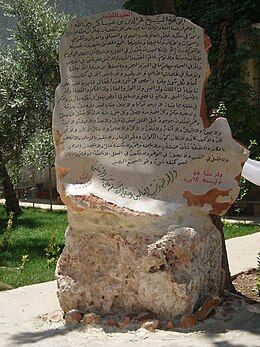Al-Qushayri
Al-Qushayri | |
|---|---|
| Title | Sufi |
| Muslim leader | |
| Part of a series on Islam Sufism |
|---|
 |
|
|
'Abd al-Karīm ibn Hawazin Abū al-Qāsim
He was born in
Biography
Al Qushayri was born into a privileged
Influence
Laṭā'if al-Isharat bi-Tafsīr al-Qur'ān is a famous work of al-Qushayri that is a complete commentary of the
His fame however, is due mostly to his al-Risala al-Qushayriyya (or the Epistle on Sufism). This text is essentially a reminder to the people of his era that Sufis had authentic ancestral tradition, as well as a defence of Sufism against the doubters that rose during that time of his life. Al-Qushayri repeatedly acknowledges his debt to, and admiration for, his Sufi master throughout his Risala. Daqqaq was instrumental in introducing Qushayri to another outstanding Sufi authority of Khurasan, al-Sulami, who is quoted on almost every page of the Risala.[10] It has sections where al-Qushayrī discusses the creed of the Sufis, mentions important and influential Sufis from the past, and establishes fundamentals of Sufi terminology, giving his own interpretation of those Sufi terms. Al-Qushayrī finally goes through specific practices of Sufism and the techniques of those practices.[9] This text has been used by many Sufi saints in later times as a standard, as is obvious from the many translations into numerous languages.
Legacy
| Part of a series on |
| Ash'arism |
|---|
 |
| Background |
Abd al-Ghafir al-Farsi said about his grandfather (Al-Qushayri):[3]
The absolute Imam, jurist, theologian, legal theorist, the interpreter of the Qu'ran, a man of letters, grammarian, writer/poet, the master of his time, God's secret among His creation, the axis of reality, source of happiness, the pole of masterhood, one who joined thee Shari'a and the Truth. He was knowledgeable in the foundations of the Ash'ari creed and in the branches of the Shafi'i school of though.
Abu al-Hasan al-Bakhirzi, the author of the book Dimyah al-Qasr, said about him:[11]
[He was] one who gathered all kinds of goodness, the one to whom all things were facilitated, and who held the bridle of every lowly thing. So, if he were to shout at a stone, it would dissolve. And if Iblis were to attend his gathering of remembrance, he would repent. He was extremely distinguished with sound logic, and an expert in the theology of the school of al-Ash’ari. The breadth of his knowledge was almost beyond human capacity. His words were beneficial and precious gems for the seekers of benefit. Verily, the feet of his pulpit are the pillows of the Gnostics. When the Sufi Shaykhs had agreed upon the favor he possessed and saw his nearness and allotment from the al-Haqq, they faded before him and disappeared in comparison with him. His carpet rolled them up in its margins. They were divided between looking at him and contemplating him. He has poems that crown the heads of his noble ministers. Thus, his furthest hopes are achieved through him.
Shaykh Amin considers Imam al-Qushayri’s work to be an inspiration to the better-known work of Al-Ghazali:[11]
If you understand the times of Imam al-Qushayri, I think it is a prelude to Imam al-Ghazali, and his book [al-Risala al-Qushayriyya], actually is, I would say, a blueprint for Imam al-Ghazali’s Ihya ‘Ulum al-Din.
Works
Among Imam al-Qushayri's writings besides al-Risala al-Qushayriyya and Laṭā'if al-Isharat bi-Tafsīr al-Qur'ān include the following:[11]
- Arba’un fi al-Hadith
- Istifadah al-Muradat
- Balaghah al-Maqasid
- Al-Ta’khir fi ‘Ilm al-Tadhkir fi Ma’ani Ism Allah Ta’ala
- Al-Taysir fi ‘Ilm al-Tafsir
- Uyun al-Ujubah fi Funun al-As’ilah
- Al-Fusul fi al-Usul
- Kitab al-Mi’raj, an account of the Night Journey[12]
- Al-Muntaha fi Nukat Ula al-Nuha.
- Nasikh al-Hadith wa Mansukhihi
- Nahw al-Qulub
- Hayat al-Arwah wa al-Dalil ila Tariq al-Salah
- Shikayah Ahl al-Sunnah bi Hikayah Ma Nalahum min al-Mihnah
- Manthur al-Khitab fi Shuhud al-Albab
See also
- List of Sufis
- List of Ash'aris
- List of Muslim theologians
- List of Iranian scientists and scholars
- Tassawwuf
References
- ^ ISBN 9004057455.
- ^ ISBN 978-1438453712.
- ^ ISBN 9781565644830.
- ISBN 9780691191621.
- ^ "Bayazid al-Bistami". World of Tasawwuf. Retrieved 2013-09-20.
- ^ Ibn Khallikan (1999). Ibn Khallikan's Biographical Dictionary. Vol. 2. Translated by William McGuckin de Slane. Royal Asiatic Society of Great Britain and Ireland. p. 170.
- ISBN 9781134551705.
- ^ Halm, H. (April 24, 2012). "al-Ḳus̲h̲ayrī". Brill – via referenceworks.brillonline.com.
- ^ a b "Session 9: Tasawwuf, Selections from al-Qushayri's al-Risala al-Qushayriyya". Lahore University of Management Sciences. Archived from the original on 26 March 2017. Retrieved 26 February 2013.
- ISBN 978-1-85964-185-9.
- ^ a b c "Imam Al-Qushayri: A Biography". imamghazali.org.
- ^ Marc Toutant, "Timurid Accounts of Ascension (miʿrāj) in Türkī: One Prophet, Two Models," in Denis Gril, Stefan Reichmuth and Dilek Sarmis (eds.), The Presence of the Prophet in Early Modern and Contemporary Islam, Vol. 1: The Prophet Between Doctrine, Literature and Arts: Historical Legacies and Their Unfolding (Brill, 2021), pp. 431–459.
7. * Chopra, R. M., "SUFISM", 2016, Anuradha Prakashan, New Delhi.
- Encyclopedia Islam
